Failed as an art dealer's helper, teacher, bookseller and preacher, 28-year-old Vincent van Gogh arrived at his parents' rectory in Etten in April 1881. He does not have a penny to spare, but he now knows exactly what he wants: to become a painter. Etten becomes his training ground.
The Van Gogh Kerk in Etten-Leur and the docudrama "Vincent van Gogh, a sower in Etten" impressively show how Vincent van Gogh ended up in Etten, how he went about his work, who his models were, how he fell madly in love and the tragedies that followed. Etten is a turning point in the life of Van Gogh. It is the beginning of his artistic career.
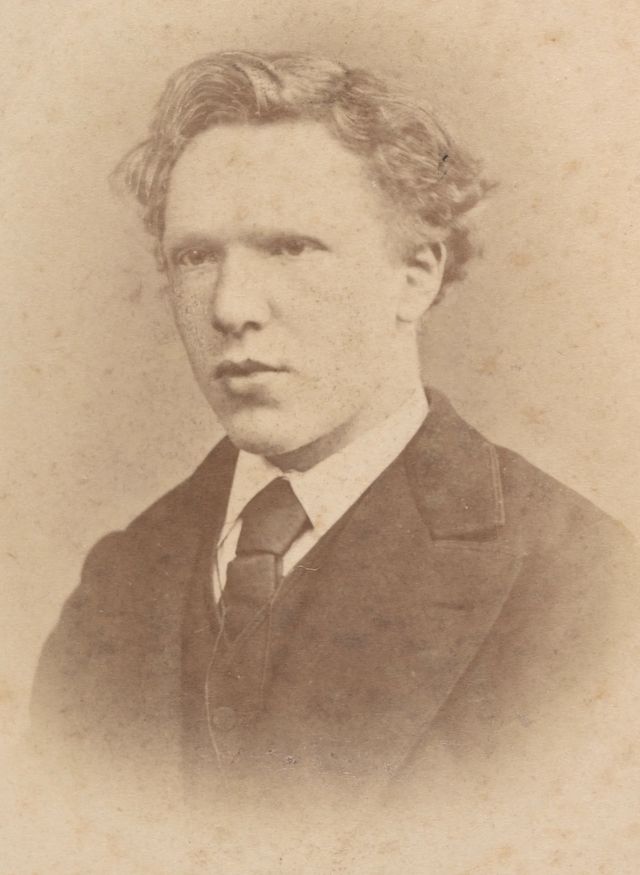
Vincent van Gogh was born in Zundert, near Etten-Leur, on March 30, 1853. Directly opposite the rectory is the village school where he learns to read and write. Drawing was taught to him at home by his mother. She also instilled in him a love of nature. They walked a lot. Probably because his mother found the interaction with the other children too rough, she pulled him out of school prematurely. At the age of 11, Vincent went to boarding school in Zevenbergen, mostly by horse and carriage from Zundert. The striking yellow carriage then passes the Zwartenberg mill in Etten-Leur, among other places. Vincent finished elementary school in Zevenbergen in two years and then (1866) went to the Rijks HBS in Tilburg where he received extensive drawing lessons. He boarded with a host family. In the course of the second year (1868), for unknown reasons, he leaves HBS early and with it Tilburg. Vincent returned to his parents in Zundert.
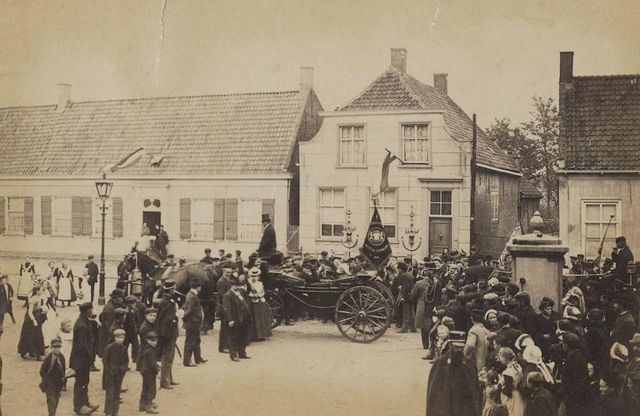
Through his uncle "Cent," Vincent was able to work as an apprentice at the international art dealer Goupil & Cie in The Hague when he was sixteen (1872), and later Vincent was transferred to Goupil in London. Here he visited famous museums in his spare time, such as the British Museum and The National Gallery. There he admired works by such "peasant painters" as François Millet and Jules Breton, among others.
Transferred to Paris in 1875, Vincent became increasingly involved in religion and, despite his interest in art, Vincent found working in the art trade increasingly uninteresting. Consequently, his employers at Goupil are increasingly dissatisfied with him. In 1876, he was fired.
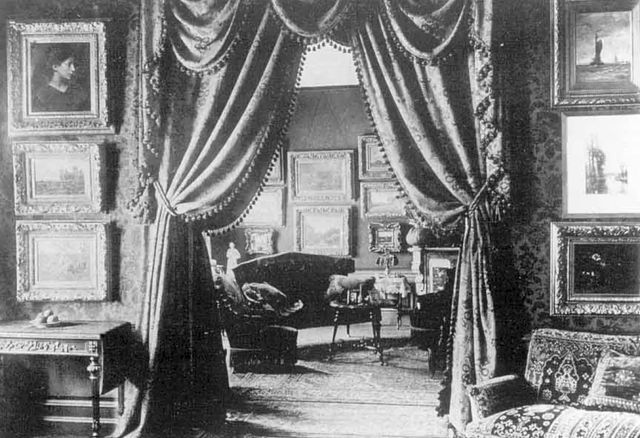
"Vincent to Theo, Paris, December 1875 "
"Today 14 days I hope to be at Etten, how I long for it you can think."
Vincent's parents moved from Helvoirt to Etten in 1875. His father, Theodorus, becomes pastor of the Dutch Reformed Congregation, in the church we now call the Van Gogh Kerk. Etten is a farming village with a mainly Roman Catholic population. Around that time the congregation had about 5,500 inhabitants, of whom only about 150 were Dutch Reformed. The family Van Gogh particularly interacts with this group. At Easter and Christmas, Vincent visits his parents. After his dismissal from Goupil & Cie, he spent nearly two weeks in Etten in April 1876. During this time he draws "Parsonage and church at Etten" in pencil and pen with brown ink.

Vincent goes back to England where he goes to work as an assistant teacher/preacher. But it is a job with few prospects. Christmas 1876 Vincent again spends Christmas with his parents in Etten. On his father's advice, Vincent does not return to England. After an advance from "Cent," Vincent is able to work as a clerk in a bookstore in Dordrecht in January 1877. Once again, he begins to concern himself with religion. His parents are very worried: Vincent is already 24 and still has no clear destination in life. After a few months, they agree that he wants to study theology in Amsterdam, but despite all the support of his family, it ultimately leads to nothing: Vincent lacks the discipline to study. He prefers to wander around the city and take long walks.

"Vincent to Theo, Dordrecht, 1877 "
"Try to be at Etten by Easter, when we are together again it will be fine."
Nevertheless, Vincent is eager to serve God, and after leaving Amsterdam he finds a new destination in Belgium. In the mining area "the Borinage," he went to work as a "lay preacher. He taught, visited the sick, and read from the Bible. There he lived in poverty among the miners. He was called "The Christ of the Coal Mine," but did not succeed in the task of bringing together a close community of faith. His contract is not renewed. Vincent's father is ashamed of his son's umpteenth failure.
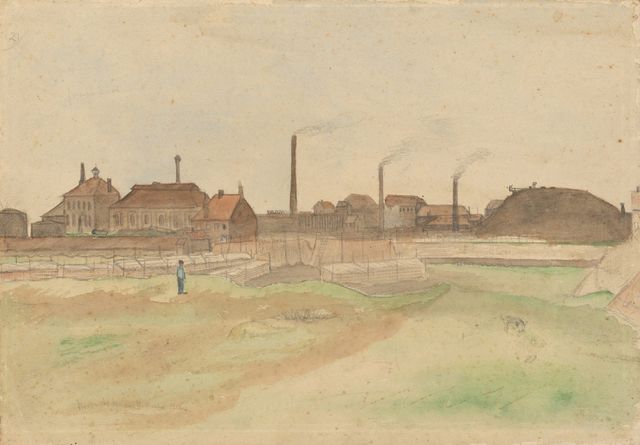
"Vincent to Theo, Wasmes, 1878 "
"The people here do have something peculiar and attractive because of their simplicity and good-heartedness like the people of Brabant in Zundert & Etten."
In letters to his brother Theo, Vincent regularly makes sketches and drawings. This leads to an important turning point in his life: Theo advises him to do more drawing. Vincent became convinced that as an artist he could also serve God. But it is a leap of faith, for Vincent is no natural talent. In October 1880 he moved to Brussels and attended art school. There he comes into contact with other artists, including Anthon van Rappard. Theo takes charge of Vincent's financial care. Brussels proves too expensive to live in, however, and Vincent wants to return to Etten. The brothers decide to invite Dad and tell him the big news. Vincent purchases two new suits so that he can appear reasonably well-groomed. He knows it is important to Pa.
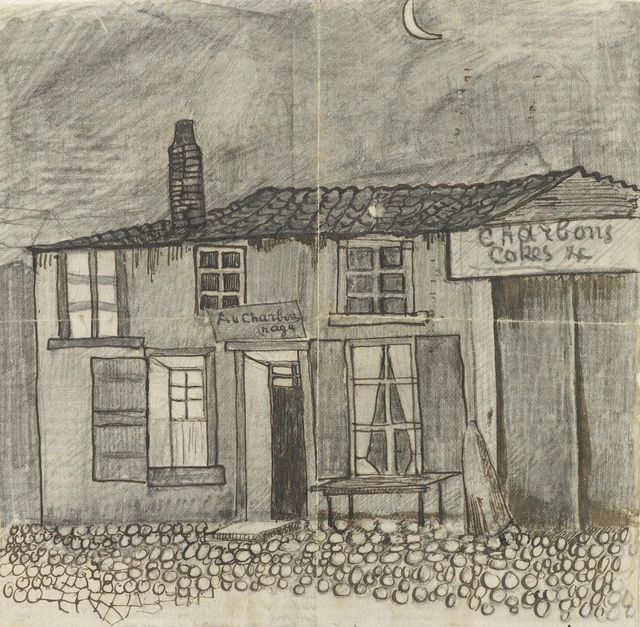
"Vincent to Theo, Brussels, April 1881 "
"'T was already lying that I spent this summer at Etten, there is dust enough there."
The visit turned out well! It was decided that Vincent should return to his parents' home to continue his development as a draughtsman and illustrator of books and magazines in Etten. On Tuesday, April 12, 1881, Vincent departed from the South Station in Brussels. Via Antwerp and Roosendaal, he arrives at the station in Etten towards evening. From there he walks down Leursestraat into the village, to his parents' rectory. It is Easter. Father Theodorus is busy preparing for the church service, but there is also time to discuss Vincent's plans. Dad promises him a real "studio. He may set it up in an outbuilding (the "teachers' room") of the spacious rectory.

"Vincent to Theo, Etten, late April 1881 "
"For some days I have been here & it is beautiful outside but the weather does not yet allow me to draw outside every day. In the meantime I have started the Millets, Le semeur is finished..."
Vincent begins by copying prints. Studies, he calls them. Jean-François Millet's "Le semeur" / "The Sower" is his favorite. Later, the theme 'The Sower' returns frequently in Van Gogh's work. Other themes he picks up in Etten are also seen in various paintings over time.
"Surely I am so glad that it is so arranged that I can work quietly here for some time, I hope to make as many studies as I can for that is the seed from which later drawings will come."
(Letter to Theo, Etten, 1881)
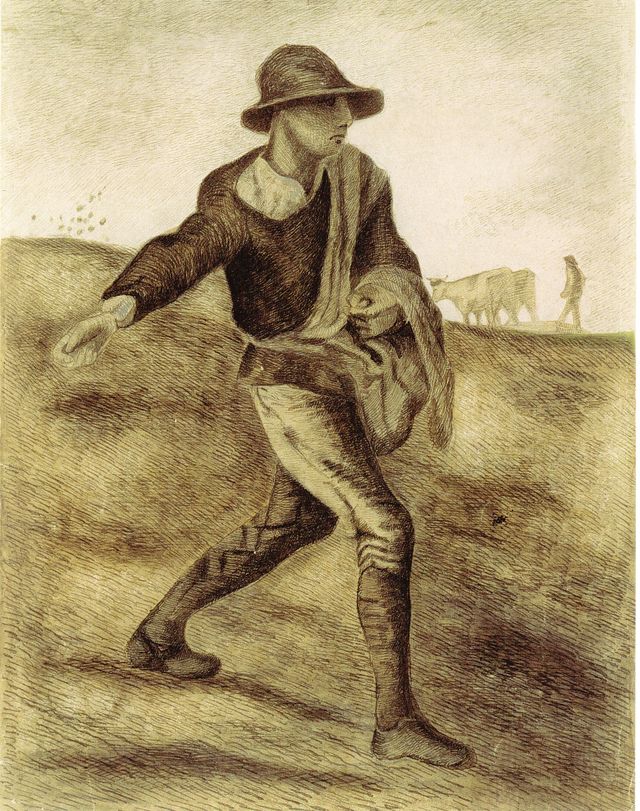
"Vincent to Theo, Etten, May 1881 "
"When it doesn't rain I go outside every day, mostly on the heath. So I made a hut on the Heike & also that shed with a moss roof on the Roozendaalschen road which they call the Protestant shed here."
In bad weather (or when it is too hot) Vincent works at home in his studio, but as soon as the weather permits, he goes outside with his drawing tools to work in nature. He often takes long walks. Vincent loves the landscape around Etten. Among other things, he creates "Hut op 't Heike" with black chalk, pencil and pen with Chinese and brown ink.
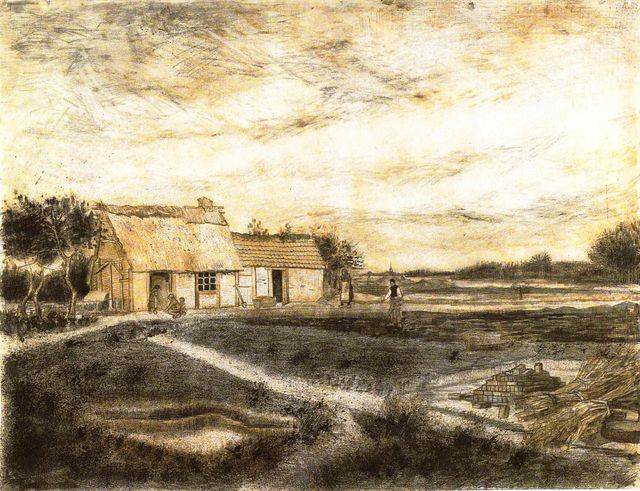
Vincent works, assiduously, often day and night, to master drawing. In June 1881 his friend Van Rappard came to stay with him. They regularly went out together, to the Liesbos and Princenhage. They draw old pollard willows and visit the small Leurse reformed church. They also go several times to the heath near Seppe, where they make sketches and drawings of the marsh the Passion.
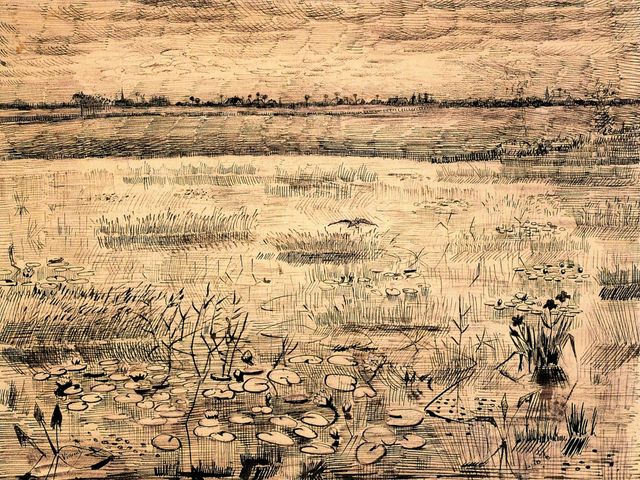
"Vincent to Theo, Etten, June 1881 "
"You should know that Rappard has been here about 12 days... We went out a lot together, several times to the heath near Seppe, to the so-called Passievaart, a big swamp."
It is the middle of summer when Vincent's cousin Kee-Vos Stricker from Amsterdam comes to stay with her son Jan at the rectory in Etten. Here she tried to break free from her grief over the loss of her husband. It is hot and Vincent falls madly in love with her. He proposes to her. This leads to great tension in the family, but Vincent refuses to renounce his feelings for Kee. Kee's "never no never" hits hard, but he decides to keep "good cheer.
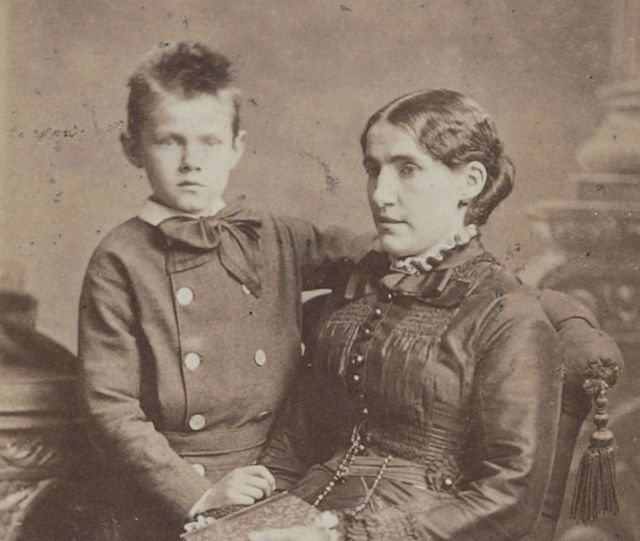
"Vincent to Theo, May 1882 (months after Vincent visited Kee with her parents in Amsterdam) "
"I put my fingers into the flame of the lamp and said, let me see her.... But they blew out the lamp I believe, and said thou shalt not see her."
Often in relative solitude, Vincent "plows ahead" with his studies. In addition to landscapes, he draws various farmers, a blacksmith's store, a carpenter's store and a clog maker. Over the course of the summer, the need to connect with other artists increases again. Time for "a trip" - as Vincent calls it - to The Hague. He is impressed by Mesdag's panorama. Painter Anton Mauve is interested in Vincent's work and he gives him tips. According to Van Gogh, Mauve also wants him to paint. The thought appeals to him, but the time is not yet ripe. On his way back to Etten, Vincent stops at Dordrecht to draw the windmills at Kinderdijk.
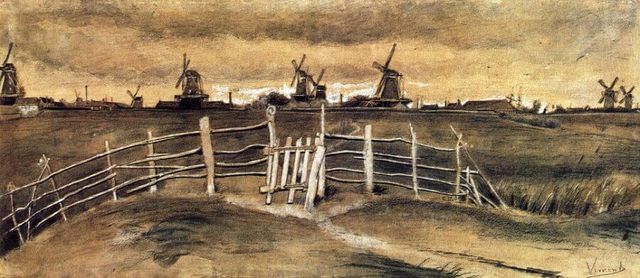
"Vincent to Theo, Etten, late June 1881 "
"To-day I have continued to draw only with pencil, worked up or drawn out with the pen, if necessary with a reed pen which works more widely."
In The Hague, Mauve advises Van Gogh to work more with live models. It marks a turnaround for Vincent. From now on he chooses subjects that Etten, his native region, has plenty to offer: Brabant peasants at work! Vincent feels strongly that his studies have given him a better understanding of figure drawing.
"Up to 5 times I have drawn a farmer with a shovel, enfin "un bêcheur" in all kinds of positions, twice a sower, twice a girl with a broom. Also a woman with a white hat peeling potatoes & a shepherd leaning on his stick and finally an old sick farmer sitting on a chair by the fireplace with his head in his hands and his elbows on his knees," he wrote enthusiastically to Theo.
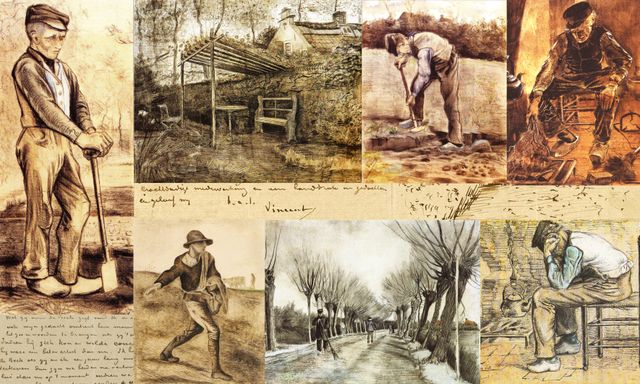
"Vincent to Theo, Etten, September 1881 "
"Spitters, sowers, plowers, men & women I must now draw incessantly. Examining & drawing all that belongs to farm life. As many others did & do. I am not as mageless now for nature as I used to be."
One of Vincent's first regular models is Pete Kaufmann. The 17-year-old boy is a gardener at the rectory. He is one of the many models Vincent prefers not to have pose in his studio or at the rectory, but in his own environment, in the yard where he lives, on Leursestraatje. Preferably in the field with a shovel or a plow. And preferably in authentic work clothes. This requires the necessary persuasion every time. He portrays the young Kaufmann as 'a sower' and 'a spitter'. Vincent searches for an ideal performance, based on the work of Millet and others.
The fact that Vincent can get models cheaply or for free is a major reason why he wants to continue working in Etten. In the city, models are much more expensive.
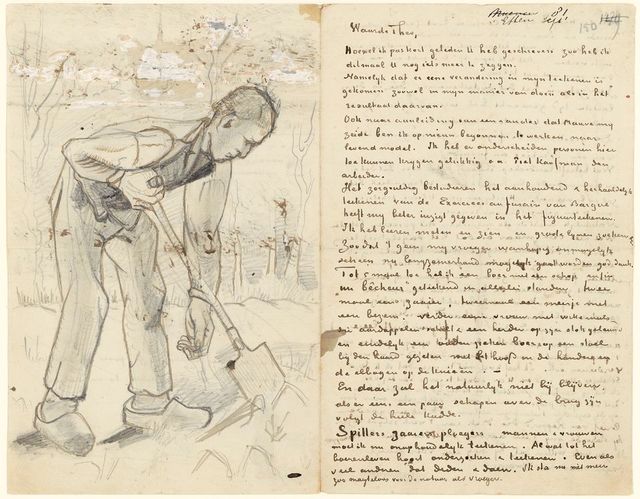
"Vincent to Theo, August 1881 "
"But what a job it is to make people understand what posing is. Farmers and citizens are desperately inveterate on the point they don't want to get rid of, that one should not want to pose other than in his Sunday suit with impossible folds..."
Figure drawing and landscape drawing now go hand in hand for Vincent. Old pollard willows become his new "models. Among other things, he immortalizes them on the beautiful "Road with Pollard Willows and Man with Broom. For this he uses pencil, chalk, pastel, watercolor, pen and brown ink on paper. Through figure drawing, Vincent now sees trees in a totally different way. As if they were living beings, with a soul.
He wrote to Theo about this: "I feel more and more that figure drawing is good, and that it has an indirect positive effect on landscape drawing. If one draws a pollard willow as if it were a living creature, and that is in fact the case, then the surroundings follow relatively naturally as long as one has concentrated all one's attention on that conscious tree and has not rested before something of the life has entered it."
The theme of "trees in the landscape" never left Vincent.
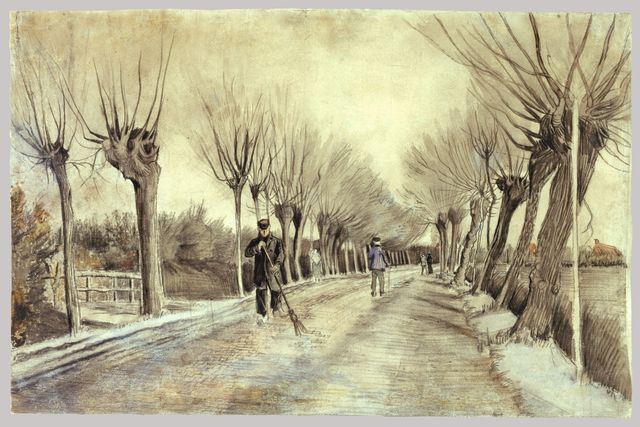
"Vincent to Anthon van Rappard, October 1881 "
"Do you know what is beautifully beautiful these days, the road to the station & to the Leur with those old pollarded willows, you have a sepia of them yourself. How beautiful those trees are now I can't tell you. Have made about 7 large studies of some of the trunks."
Even after Kee Vos van Etten leaves for Amsterdam, Vincent continues to bombard her with letters for months. He writes fervently about true love. Theo supports his brother. In a letter to their parents he asks for understanding for Vincent's feelings. Theo sends Vincent money so that Vincent can visit Kee in Amsterdam. Near the end of 1881, this mission ends in a debacle and an even greater quarrel in the family. Vincent goes to The Hague, where painter Anton Mauve encourages him to work with paint. Mauve had already given Vincent a painting kit with jars of oil paints and painting brushes in October. In November, he spent several weeks at Mauve's studio in The Hague. Here he painted his first works with oils, three still lifes including "Still Life with Cabbage and Clogs. After nearly a month in The Hague, Vincent ran out of money. Just before Christmas he therefore returned to Etten.

"Vincent to Theo, December 18, 1881 "
"And Mauve has pointed out and said things to me which I cannot do just like that but which I will gradually put into practice. But I must work on, and when I get back to Etten a few changes will be necessary..."
Vincent resolves to live and work in Etten all winter. But once home at the rectory in Etten, things get completely out of hand between him and his father. The issue of "Kee Vos," the fact that Vincent had consumed "so terribly much" in The Hague and that his eldest son was still unsuccessful to this day, irritates Dad greatly. When Vincent refuses to attend his father's Christmas service in church, the bomb bursts. Theodorus evicts Vincent from the house.

After the break with his father, Vincent immediately returned to The Hague. Here he continued to work on his career as a painter with Anton Mauve. He never returned to Etten. Only three months later - after seven years - his parents also left the village. Theodorus received an appointment as pastor in Nuenen.
Later Vincent continues to write regularly about Etten. More than six years after his departure, from the southern French town of Arles, Vincent asks his mother to send him some more Etten sketches. Friend painter Paul Gaugain encourages Vincent to paint more often from the imagination. With this in mind, he creates the nostalgic canvas "Memory of the Garden at Etten" / "Souvenir du jardin à Etten. It is Vincent's tangible and fond memory of his time Etten.
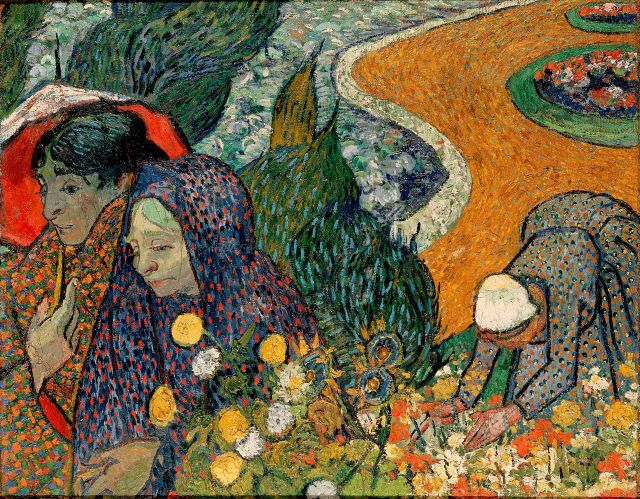
"Vincent to Willemien, November 1888 "
"So, I know it may hardly be similar, but for me it reflects the poetic nature and style of the garden as I feel it."